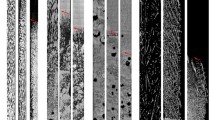Abstract
The distribution of alloying elements and the corresponding structural evolution of Mn–Sb alloys in magnetic field gradients were investigated in detail. It was found that a high magnetic field gradient could control the distribution of solute element in the alloys during the solidification process and therefore resulted in the coexistence of both primary MnSb and Sb phases or the aggregation of the primary MnSb with a continuous change in morphology. The positions where these primary phases located depended on the direction of field gradient. The control of the solute element distribution by a high magnetic field gradient was realized through the magnetic buoyancy force that could drive the migration of Mn element in the melt, originating from the difference in the magnetic susceptibility between Mn and Sb. The effectiveness of this control depends on the alloy composition, specimen dimension, cooling rate, and BdB/dz value.
Similar content being viewed by others
References
F. Liu, G.C. Yang: Rapid solidification of highly undercooled bulk liquid superalloy: Recent developments, future directions. Int. Mater. Rev.51145 (2006)
T. Watanabe, S. Tsurekawa, X. Zhao, L. Zuo: Grain boundary engineering by magnetic field application. Scr. Mater.54969 (2006)
S. Suresh: Graded materials for resistance to contact deformation and damage. Science2922447 (2001)
Y. Fukui, Y. Watanabe: Analysis of thermal residual stress in a thick-walled ring of Duralcan-base Al–SiC functionally graded material. Metall. Mater. Trans.274145 (1996)
H.P. Utech, M.C. Flemings: Elimination of solute banding in indium antimonide crystals by growth in a magnetic field. J. Appl. Phys.352021 (1966)
D.L. Cox: Quadrupolar Kondo effect in uranium heavy-electron materials? Phys. Rev. Lett.591240 (1987)
N. Frederick, M.B. Maple: Crystalline electric-field effects in the electrical resistivity of PrOs4Sb12. J. Phys. Condens. Matter154789 (2003)
C.J. Wang, Q. Wang, Z.Y. Wang, H.T. Li, K. Nakajima, J.C. He: Phase alignment and crystal orientation of Al3Ni in Al–Ni alloy by imposition of a uniform high magnetic field. J. Cryst. Growth3101256 (2008)
H. Yasuda, I. Ohnaka, O. Kawakami, K. Ueno, K. Kishio: Effect of magnetic field on solidification in Cu–Pb monotectic alloys. ISIJ Int.43942 (2003)
Q. Wang, C.J. Wang, T. Liu, K. Wang, J.C. He: Control of solidified structures in aluminum-silicon alloys by high magnetic fields. J. Mater. Sci.4210000 (2007)
Q. Wang, C.S. Lou, T. Liu, N. Wei, C.J. Wang, J.C. He: Fabrication of MnBi/Bi composite using dilute master alloy solidification under high magnetic field gradients. J. Phys. D42025001 (2009)
T. Liu, Q. Wang, A. Gao, C. Zhang, C.J. Wang, J.C. He: Fabrication of functionally graded materials by a semi-solid forming process under magnetic field gradients. Scr. Mater.57992 (2007)
E. Beaugnon, R. Tournier: Levitation of organic materials. Nature349470 (1991)
M.A. Weilert, D.L. Whitaker, H.J. Maris, G.M. Seidel: Magnetic levitation and noncoalescence of liquid helium. Phys. Rev. Lett.774840 (1996)
R.F. Tournier, E. Beaugnon, J. Noudem, S. Rakotoarison: Materials processing in a magnetic force opposed to the gravity. J. Magn. Magn. Mater.2094226 (2001)
Q. Wang, T. Liu, A. Gao, C. Zhang, C.J. Wang, J.C. He: A novel method for in situ formation of bulk layered composites with compositional gradients by magnetic field gradient. Scr. Mater.561087 (2007)
M. Hansen Constitution of Binary Alloys(McGraw-Hill, New York 1958)132
C.S. Lou, Q. Wang, C.J. Wang, T. Liu, K. Nakajima, J.C. He: Migration and rotation of TiAl3 particles in an Al-melt solidified under high magnetic field conditions. J. Alloys Compd.472225 (2009)
M.F.X. Gigliotti, G.A. Colligan, G.L.F. Powell: Halo formation in eutectic alloy systems. Metall. Trans.1891 (1970)
S.T. Bluni, M.R. Notis, A.R. Marder: Nucleation characteristics and microstructure in off-eutectic Al–Zn alloys. Acta Metall. Mater.431775 (1995)
H.T. Li, J.T. Guo, K.W. Huai, H.Q. Ye: Microstructure characterization and room temperature deformation of a rapidly solidified NiAl-based eutectic alloy containing trace Dy. J. Cryst. Growth290258 (2006)
R. Dupree, E.F.W. Seymour Liquid Metals(Marcel Dekker, New York 1972)461
D.J. Steinberg: A simple relationship between the temperature dependence of the density of liquid metals and their boiling temperatures. Metall. Trans. A51341 (1974)
Author information
Authors and Affiliations
Corresponding author
Rights and permissions
About this article
Cite this article
Liu, T., Wang, Q., Gao, A. et al. Distribution of alloying elements and the corresponding structural evolution of Mn–Sb alloys in high magnetic field gradients. Journal of Materials Research 25, 1718–1727 (2010). https://doi.org/10.1557/JMR.2010.0226
Received:
Accepted:
Published:
Issue Date:
DOI: https://doi.org/10.1557/JMR.2010.0226




